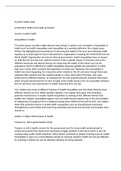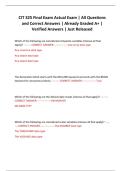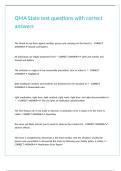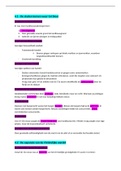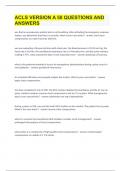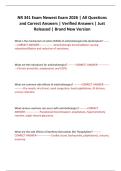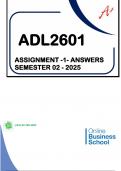STUDENT NUMBER: 62191411
ASSIGNMENT 02
UNIQUE NO.: 877195
HEC101V
HEALTH EDUCATION
DUE DATE: 28 MAY 2021
,QUESTION 01:
1.1. Briefly define health according to the United Nations world Health
Organization.
According to WHO, “Health” is described as “The state of complete physical, mental and social well-
being and not merely the absence of disease or infirmity.”
This means that health is not defined by the absence of illness but rather the state of one’s overall
well-being.
1.2. The National Children’s Right Committee (NCRC) states that for the majority of
South Africans who live in depressed rural areas or in overcrowded townships
and unsafe and unsanitary housing, are at high risk of disease and other issues.
Briefly explain the most important factors in the environment that contribute
to ill-health such as disease, disability and death in South Africa.
• A lack of sewers, drains and services for disposing of solid and liquid waste:
Waste and various forms of waste have a huge impact on environmental health risks. Some
wastes give off dangerous gasses such as methane which can be toxic and even explosive,
impacting the ecosystem and contributing greatly to the planet’s greenhouse effect. If and when
waste isn’t properly disposed of, it can have a very negative impact on the environment and
especially on the people that are exposed to it.
• A lack of a safe and sufficient water supply:
Clean water is essential in the health compartment, because unclean water sources can severely
compromise people’s health and overall well-being. When water is polluted and unfit for
consumption, it may contain pathogens of deadly diseases like cholera, bilharzia, typhoid and
others which can be fatal.
• Overcrowded and inadequate living conditions:
Inadequate shelter and covering and a lack of space are major factors in the transmission of
diseases with epidemic potential, such as acute respiratory infections, meningitis, tuberculosis,
etc. Outbreaks of diseases are more frequent and more severe when the population density is
high.
• Insufficient safe and clean fuels for domestic cooking and heating:
This means that most often, expensive and unhealthy fuels are being used – such as coal, paraffin,
wood, etc. – which cause pollution as well as serious health problems for infants and children (as
well as adults) when breathing in the toxins that burning these unsafe fuels release.
Together with widespread use of kerosene stoves, heaters and lamps – these practices also result
in many serious injuries and deaths from scalds, burns and poisoning.
• Poor control of workplace environments, in both formal as well as informal sectors leading to
chemical and biological contamination of land, air, water and food resources:
This can result in unacceptable levels of pollution.
According to the World Health Organization (WHO), about 829 000 people are estimated to die
each year as a result of drinking polluted, unsafe drinking water as well as not having access to
1 STUDENT NO.: 62191411
, proper sanitation and hand hygiene. Some diseases like humidifier fever are associated with the
exposure to toxins from microorganisms that can grow in large building ventilation systems.
However, theses diseases can also be traced to microorganisms that grow in home heating and
cooling systems and humidifiers fuelled by unsafe water sources. Pollution is a serious health
factor that can cause various health risks.
1.3. Read the following extract and answer the question below.
Examine ways in which environmental education is integrated in school
subjects.
There is no one universal approach on how environmental education can be included in the school
curriculum or educational programmes, yet there are various ways in which it can be implemented.
There are three different ways in which Environmental Education can be implemented in the school
curriculum:
• It can be included in the school curriculum as an independent subject.
• It can be treated as a cross-curricular issue permeating the whole curriculum and be
integrated into existing subjects.
• It can be taught as a theme, organized around significant issues and problems.
Each one of the above-mentioned strategies on integrating Environmental Education in the school
curriculum, but according to UNESCO; “environmental education should not be just one more subject
to add to existing programs, but should be incorporated into programs intended for all learners,
whatever their age….” [1977, p20.]
Although it is argued that it is easier to teach, and will have its own identity when it is a separate
subject, it will have a narrow focus and not be related to the other subjects. In addition, not everybody
may study it if the learners have the mandate to choose the subjects that they want to study. The
environment is a cross-curricular issue, hence the inclusion of environmental education into the school
subjects as a cross-curricular issue. It is argued that integrating environmental education into existing
subjects will help learners develop understanding, skills and attitudes, which will enable them to take
an active and responsible role in the conservation of the environment.
The integration of Environmental Education will differ in context depending on the subject in which it
has been integrated. See the table below for a list of environmental topics or sub-topics found in
different subjects:
SUBJECT ENVIRONMENTAL EDUCATIONAL
TOPIC/ACTIVITY
Social Studies • Cleanliness at home, school and in the
neighbourhood.
• Conservation of the environment.
• Natural resources.
2 STUDENT NO.: 62191411
ASSIGNMENT 02
UNIQUE NO.: 877195
HEC101V
HEALTH EDUCATION
DUE DATE: 28 MAY 2021
,QUESTION 01:
1.1. Briefly define health according to the United Nations world Health
Organization.
According to WHO, “Health” is described as “The state of complete physical, mental and social well-
being and not merely the absence of disease or infirmity.”
This means that health is not defined by the absence of illness but rather the state of one’s overall
well-being.
1.2. The National Children’s Right Committee (NCRC) states that for the majority of
South Africans who live in depressed rural areas or in overcrowded townships
and unsafe and unsanitary housing, are at high risk of disease and other issues.
Briefly explain the most important factors in the environment that contribute
to ill-health such as disease, disability and death in South Africa.
• A lack of sewers, drains and services for disposing of solid and liquid waste:
Waste and various forms of waste have a huge impact on environmental health risks. Some
wastes give off dangerous gasses such as methane which can be toxic and even explosive,
impacting the ecosystem and contributing greatly to the planet’s greenhouse effect. If and when
waste isn’t properly disposed of, it can have a very negative impact on the environment and
especially on the people that are exposed to it.
• A lack of a safe and sufficient water supply:
Clean water is essential in the health compartment, because unclean water sources can severely
compromise people’s health and overall well-being. When water is polluted and unfit for
consumption, it may contain pathogens of deadly diseases like cholera, bilharzia, typhoid and
others which can be fatal.
• Overcrowded and inadequate living conditions:
Inadequate shelter and covering and a lack of space are major factors in the transmission of
diseases with epidemic potential, such as acute respiratory infections, meningitis, tuberculosis,
etc. Outbreaks of diseases are more frequent and more severe when the population density is
high.
• Insufficient safe and clean fuels for domestic cooking and heating:
This means that most often, expensive and unhealthy fuels are being used – such as coal, paraffin,
wood, etc. – which cause pollution as well as serious health problems for infants and children (as
well as adults) when breathing in the toxins that burning these unsafe fuels release.
Together with widespread use of kerosene stoves, heaters and lamps – these practices also result
in many serious injuries and deaths from scalds, burns and poisoning.
• Poor control of workplace environments, in both formal as well as informal sectors leading to
chemical and biological contamination of land, air, water and food resources:
This can result in unacceptable levels of pollution.
According to the World Health Organization (WHO), about 829 000 people are estimated to die
each year as a result of drinking polluted, unsafe drinking water as well as not having access to
1 STUDENT NO.: 62191411
, proper sanitation and hand hygiene. Some diseases like humidifier fever are associated with the
exposure to toxins from microorganisms that can grow in large building ventilation systems.
However, theses diseases can also be traced to microorganisms that grow in home heating and
cooling systems and humidifiers fuelled by unsafe water sources. Pollution is a serious health
factor that can cause various health risks.
1.3. Read the following extract and answer the question below.
Examine ways in which environmental education is integrated in school
subjects.
There is no one universal approach on how environmental education can be included in the school
curriculum or educational programmes, yet there are various ways in which it can be implemented.
There are three different ways in which Environmental Education can be implemented in the school
curriculum:
• It can be included in the school curriculum as an independent subject.
• It can be treated as a cross-curricular issue permeating the whole curriculum and be
integrated into existing subjects.
• It can be taught as a theme, organized around significant issues and problems.
Each one of the above-mentioned strategies on integrating Environmental Education in the school
curriculum, but according to UNESCO; “environmental education should not be just one more subject
to add to existing programs, but should be incorporated into programs intended for all learners,
whatever their age….” [1977, p20.]
Although it is argued that it is easier to teach, and will have its own identity when it is a separate
subject, it will have a narrow focus and not be related to the other subjects. In addition, not everybody
may study it if the learners have the mandate to choose the subjects that they want to study. The
environment is a cross-curricular issue, hence the inclusion of environmental education into the school
subjects as a cross-curricular issue. It is argued that integrating environmental education into existing
subjects will help learners develop understanding, skills and attitudes, which will enable them to take
an active and responsible role in the conservation of the environment.
The integration of Environmental Education will differ in context depending on the subject in which it
has been integrated. See the table below for a list of environmental topics or sub-topics found in
different subjects:
SUBJECT ENVIRONMENTAL EDUCATIONAL
TOPIC/ACTIVITY
Social Studies • Cleanliness at home, school and in the
neighbourhood.
• Conservation of the environment.
• Natural resources.
2 STUDENT NO.: 62191411

